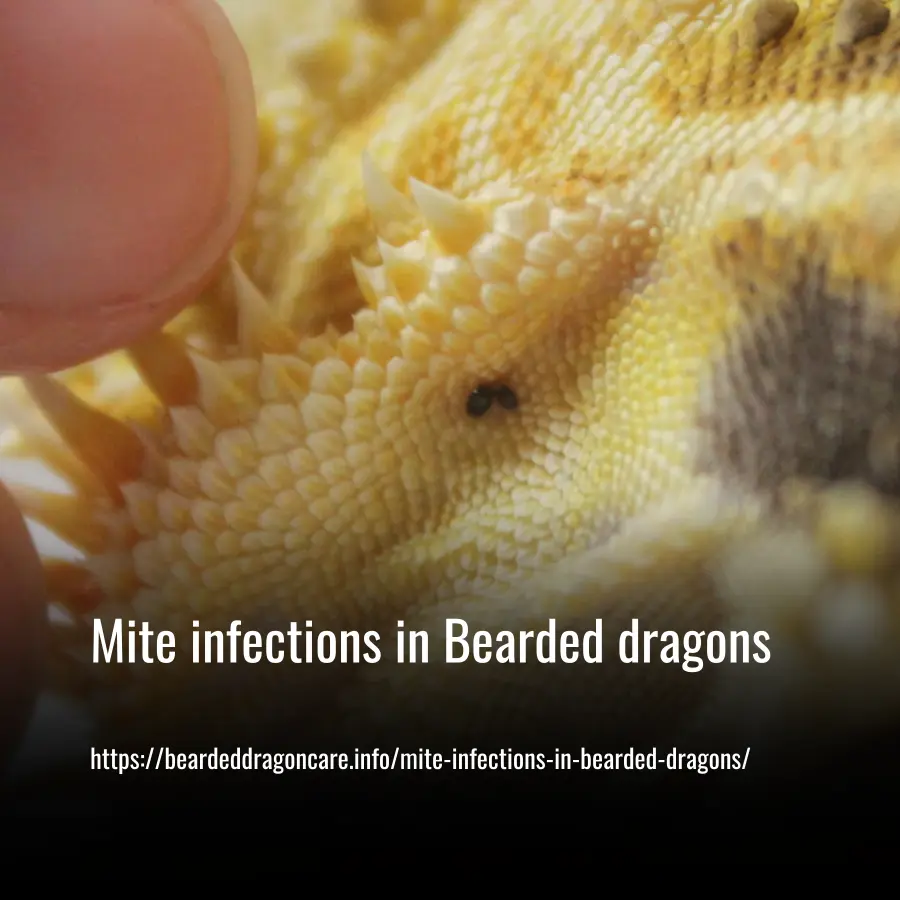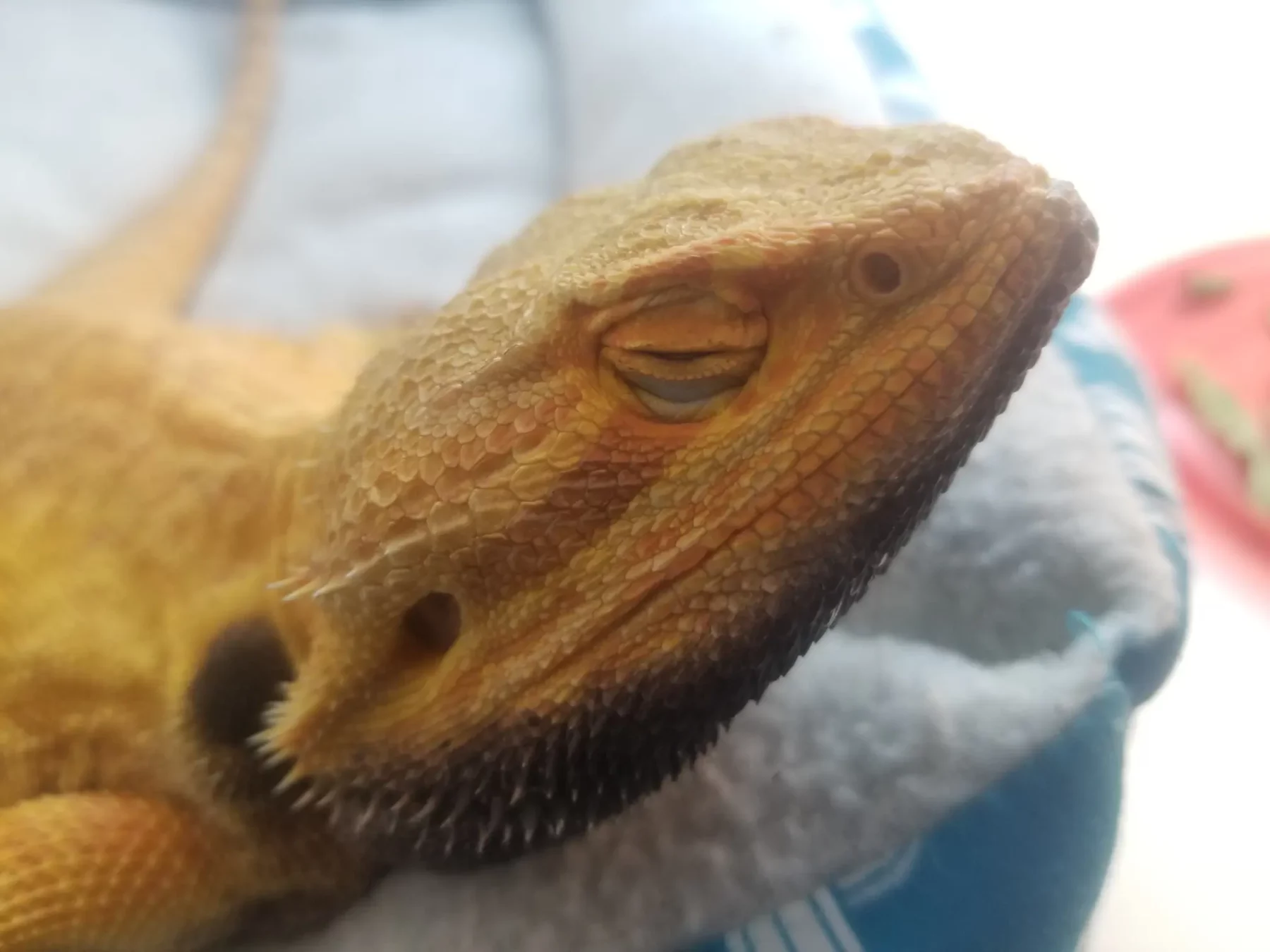Mites are small, tiny tick-like parasites that inhabit the outside skin of many reptile species, including Bearded dragons.
These tiny (only a few millimeters in length) parasites attach themselves to their host, bore through the skin, and suck blood – leading to significant blood loss, loss of appetite, and a weakened immune system. Often diseases are transmitted from one Bearded dragon to another via mites. Mite infections also affect the overall health and appearance of Bearded dragons.

What are Mites?
Mites are small, parasitic bugs that use larger animals as hosts and they’re very similar to fleas or lice. Although they’re not a particularly common problem for bearded dragons, they’re more likely to show up in captivity situations. Wild beardies usually get rid of mites naturally when they shed their skin but this isn’t so easy for captive beardies who have no way to go outside their enclosure.
It’s in these situations that the mites stay on their shed skins and can cause health problems. Mites tend to be found under the scales of a bearded dragon, around its eyes and ears, and around areas with thin scales. When a bearded dragon is affected by mites, it’s known as acariasis.
Types of Mites
There are several types of mites that can affect our beloved reptiles. Snake Mites, the most common kind, are black or brown and can be found in skin folds, armpits, mucous membranes, and other damp spots on the animal’s body.
Pterygosomid Mites are more likely to infect lizards and have a reddish-orangish color; they usually don’t stay confined to mite pockets but can actually spread across the entire skin of their host.
Harvest Mites, also known as Chiggers, will feed on any mammal or bird including humans. They attach to the skin for five or six days and turn it red or orange and create an orange crust.
Storage Mites appear when there is poor husbandry which often includes inadequate humidity levels; they often share a habitat with lizards who eat insects so you may find these little pests in feces samples too.
In all cases, your veterinarian will require some kind of sample for diagnosis – feces when dealing with storage mites for example. Knowing the type of mite that has taken up residence in your reptile’s environment helps keep them safe from infestations.
The Life Cycle of Mites
The life cycle of mites is an interesting one. The mites can remain hidden in their scaly crevices on the host lizard for their entire lives, and even lay their eggs in the skin folds of the host. The five stages of the mite life cycle are eggs, larvae, protonymphs, deutonymphs, and adults.
The eggs are incredibly small, with one pole darkening as the baby mite develops. Larvae need 75% relative humidity to survive and will stay close to the egg but won’t feed. Whereas, protonymphs are more actively feeding and depending on the type could feed on blood, skin, or lymph. As a way to defend themselves, they hide under the bearded dragon’s scales or reside around its eyes.
When it reaches the next stage – deutonymphs – they become nonfeeding yet temporarily detach from the host. The final stage of an adult mite results in them returning to feeding on the host animal and reproducing themselves before laying new eggs – completing their lifecycle which takes about three weeks altogether!
Where Do Bearded Dragon Mites Come from?
Bearded Dragon Mites can be a nuisance and if you don’t know where they come from, you may never be able to prevent and eliminate the mites on your beloved bearded dragon. So, it’s important to understand their origins and potential risks of contact.
Mites that are prone to causing diseases can spread to bearded dragons from many sources. Pet shops, infested animals in pet shops, and even pet supplies that haven’t been properly inspected can all be carriers of these pesky critters. If you take a bearded dragon home from a store that is already suffering from mite infestation, this may result in the further spreading of the mites to other pets in your home.
Therefore, it is wise to inspect any newly purchased beardies thoroughly before introducing them into your home environment. Additionally, if there are any signs that animals or pet supplies have been infested with mites then these should be avoided.
How Do Bearded Dragons Get Mites?
Bearded dragons can be infested with mites in several ways, but the most common cause is owner negligence. This includes not taking general hygienic measures, such as having another reptile that is infested sharing space with your beardie.
Mites can also be acquired from dirty enclosures or recently bought supplies that have already been infected by them.
How Do Bearded Dragon Mites Spread?
Bearded Dragon Mites are a surprisingly fast-spreading pest that can quickly become an issue. They breed and reproduce very quickly, making the growth of their population far more rapid than expected due to their short life cycles.
Plus, when bearded dragons are kept in close proximity, like in a crowded enclosure, the mites can easily escape and spread to the terrariums nearby or even within the same room of a house in as little as one day.
Mites are especially likely to be found on new reptiles coming home from a pet store, which is why it’s important for owners to always conduct a careful inspection before bringing a new reptile home.
Additionally, improper husbandry increases the risk of an infestation and may lead to serious health issues for your bearded dragon. So if you see signs of mite infestation, take action right away!
Where are Mites Found on Bearded Dragons?
Mites are occasionally found on bearded dragons, but they are not overly common. However, if your beardie does have them, you’ll likely find them in or around any of the following areas: near the eyes and ears; under larger scales; skin folds; fecal matter; and back and front legs.
It’s important to regularly inspect these areas to make sure any infestation is discovered before it gets out of hand. So if you own a beardie, be sure to keep an eye out for signs of mite presence in those difficult-to-reach places! After all, it’s always better to catch a mite infestation before it has a chance to spread.
Health Effects of Bearded Dragon Mites
Bearded dragons can be afflicted with mites, which can lead to a number of health problems. The most common symptoms of bearded dragon mites are skin damage, dehydration, and impaired growth.
Additionally, hyperkeratosis (thickening of the outer layer of skin) and bacterial or viral infections from bites or lesions may occur. Anemias, anorexia, and impairments in skin shedding may also result due to infestation by mites.
If a bearded dragon is suffering from any of these symptoms, it is important to seek medical help immediately as the effects may be severe and long-term if not treated properly.
How Do You Treat a Bearded Dragon with Mites?
Treating a Bearded Dragon with mites is easy with the right steps.
1. Remove Your Beardie From Their Tank
Removing your beardie from their tank is an important part of maintaining a healthy environment for them to live in. You’ll need to locate a safe and easily transportable container, like an extra tank, that will act as their home while you’re cleaning theirs.
It’s important that once you’re done cleaning, the temporary container is either thrown away or thoroughly cleaned so it doesn’t transfer any bacteria or infections to your beardie when you put them back into their clean habitat. By providing your beardie with a new space for temporary residence while you clean theirs, you can ensure they stay safe and happy!
2. Make Your Beardie’s Betadine Bath
Preparing your Beardie’s Betadine Bath is simple and straightforward. To start, simply mix the antiseptic Betadine solution with warm water until it becomes a light brown color, which should be similar to the color of muddy water.
Then, make sure that you are using a container big enough to fit the entire body of your Beardie so they can take their bath in it.
3. Proceed to Bathe Your Beardie
Bathing your beardie is a relatively easy process and can be incredibly helpful in getting rid of pesky mites. Firstly, you need to fill a bowl or sink with warm, comfortable bath water mixed with a few drops of Betadine.
Then proceed to pour the water over your beardie’s body, covering as much of him or her as possible. Make sure that you don’t submerge them in the water, just use it for pouring over them.
4. Use a Cloth to Apply More Solution
Using a cloth to apply a diluted betadine/water solution is an effective way of keeping your Bearded Dragon clean. After the bath, take the cloth and dip it into a different container with the solution.
Gently rub the cloth all over your dragon’s body from head to tail, including around their ears and neck – but make sure to stay away from their eyes as it can be harmful to them.
Allow the solution to sit on them for about ten minutes before rinsing it off completely.

Mite infections in Bearded dragons
How will you know?
Mite infections in pet Bearded dragons are fortunately not common. When present, mites can often be seen as little moving specs on the skin of Bearded dragons. One will also find them attached under the edges of larger scales, around the eyes, ears, and any place on the body where the scales are thinner.
Other signs indicating mite infections in Bearded dragons include the following:
- excessive water soaking behaviour
- loss of appetite
- weight loss
- poor body condition
- shedding problems
Symptoms Of Mite Infestations
Bearded dragons with mites may show strange behaviors and have health problems.
- Dull skin
- Crusty scales
- Hemorrhages
- Depression
- Loss of appetite
- Lethargy
- Rubbing against cage furniture; itching
- Soaking in water more than usual
- Weight loss
- Incomplete shedding
- Sunken eyes
What should you do?
Being an infectious disease, mite infections in Bearded dragons will spread to other Bearded dragons. Because mites hide and breed in small places like cracks, under cage furniture, and inside the bedding and substrate, they can be tricky to get rid of.
Before doing anything else, isolate all affected Bearded dragons by placing them in separate, large enough, plastic containers with a paper-based substrate and as little as possible cage furniture.
Although some home treatments can be considered, rather make an appointment with your closest reptile-friendly veterinarian. Apart from being contagious, mite infections in Bearded dragons can be a serious, life-threatening condition.
The safest home treatment that can be attempted is careful soaking in lukewarm water (taking care not to drown the Bearded dragons). Mites won’t be able to breathe underwater and will either drown or try to move to the surface.
Apart from affected Bearded dragons, the environment should also be treated for mites. Emptied-out enclosures and cage furniture should be thoroughly cleaned and treated properly for insects. The substrate, any wooden and/or finer cage furniture should rather be discarded.
Prevention of mite infections in Bearded dragons
As with many conditions, mite infections should rather be prevented. The most important aspect of Bearded dragon mite prevention is proper hygiene and quarantine. Before the introduction to a colony and/or permanent enclosure, newly obtained Bearded dragons should be quarantined. This will allow proper inspection, monitoring, and prompt treatment if mites (and other diseases) arise. This will also prevent mite infestations and the spread of mites and their diseases to other Bearded dragons.
Regular health checks
As with all pets, it is recommended to have even a healthy Bearded dragon evaluated by a reptile-friendly veterinarian on a routine or regular basis. Important problems like mite infections can be identified early and rectified before it becomes a problem. It is preferable to have a Bearded dragon evaluated for parasites at the time of purchase, before or during its quarantine period, and then at least every six months after that.
Quarantine New Beardies
It’s essential to quarantine any new beardies you bring into your home as they can be affected by mites and parasites. By quarantining them, you separate the new ones from your existing reptiles so you can be sure that no mites or other nasties have been brought in.
Don’t Buy Beardies From Untrustworthy Sources
When looking for a new pet, it’s important to do your research and only purchase from reputable breeders or sellers. Sadly, there are some particularly untrustworthy pet breeders or sellers out there who don’t care an inch about the well-being of their animals and don’t hesitate to sell pets that have mites, or any other health issues. That’s why people must always be extra diligent when getting a bearded dragon.
Never Handle Reptiles at Pet Stores or Expos
When it comes to reptile handling, it’s advisable that you avoid pet stores and pet expos altogether. Many of these places are known for being unreliable, so you’d be better off not taking any chances.
It’s not only irresponsible to handle reptiles at pet stores or expos but also dangerous too. Not only can you spread mites onto your beardie when handling these reptiles – the consequences of which can be potentially life-threatening – but other reptiles kept in these places could carry various diseases that could be passed onto yours as well.
How to Clean Out Your Beardie’s Habitat?
Cleaning out your Beardie’s habitat is essential to keeping them healthy and happy. First, you will want to target the areas around their tank – use a pet-safe disinfectant and vacuum any rugs, fabrics, or surfaces that could be carrying mites.
Next up is cleaning the tank itself – start by throwing out all non-disinfectable items from inside, such as the substrate and wooden branches/core bark. After that, clean the whole glass tank using hot soapy water and you can also add a bleach/water solution for extra protection. Let it air for 10-15 minutes before rinsing with hot water, and don’t forget to clean all lighting fixtures too.
When cleaning toys, leave them soaking in a bleach solution for several hours. Allow them to air dry outside or near an open window, which can take up to a few hours. As a final step place a pesticide strip in the tank and make sure to seal it off with tape. Let it sit for several hours before airing it out outside again – this step also requires time so plan accordingly!
Once everything is set and clean, your dragon can finally return home. Keep an eye on them for the next couple of weeks! Offer some paper towels as a substrate during this period as well just in case there are still any lingering mites around their habitat.
FAQs
What Do Mites Do To Your Bearded Dragons?
Mites are parasites, similar to fleas. They bite and sip the blood of bearded dragons. After consuming adequate amounts of blood from bearded dragons, mites lay eggs inside their habitats. Also, mites transport bacteria and viruses that can be detrimental to bearded dragons.
What Do Mites On A Bearded Dragon Look Like?
Little red or black spots on bearded dragons are triggered by mites. These microscopic, transparent pests live in reptiles, such as bearded dragons, and bite them to drink their blood. It is challenging to distinguish the mites on bearded dragons since they are both extremely small and colorless.
Why Are Mites Hard To Get Rid Of?
Due to their ability to quickly reproduce, hide, and spread with ease, mites will infest all areas of a room if found in a bearded dragon’s enclosure. Unfortunately, the chemical products usually applied to rid an area of mites are also dangerous for reptiles. Thus, it is necessary to use a double-treatment procedure when dealing with them.
Is Bearded Dragon Mite Spray Effective?
There are multiple insect repellant sprays that can efficiently get rid of an account for mites. To obtain the best results, using the spray correctly is crucial.
Are Bearded Dragon Mites Contagious, And Do They Spread From One Beardie To Other Reptiles?
Bearded Dragon Mites are contagious and can be transferred between organisms, leading to damaging health issues.
Can Humans Contract Bearded Dragon Mites?
If humans come in contact with infested reptiles, they can pick up mites which can lead to serious illnesses such as botulism and salmonella.
Conclusion
In conclusion, mite infections are a common issue that can affect your bearded dragon’s health and happiness in an array of ways. To ensure your pet stays healthy and happy, it is important to regularly monitor for any signs of mites and act quickly if you spot anything. Doing so will help keep your pet safe from the effects of infestation and also keep them feeling their best!
